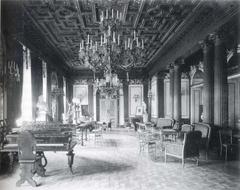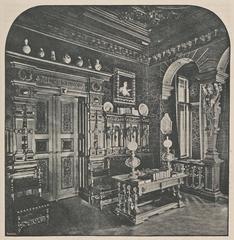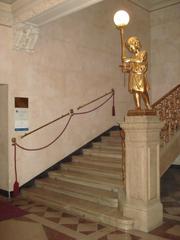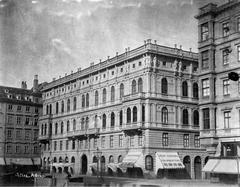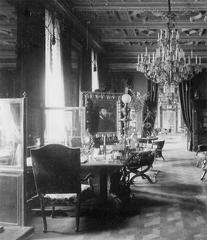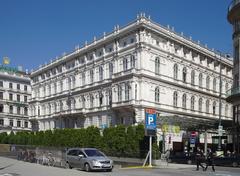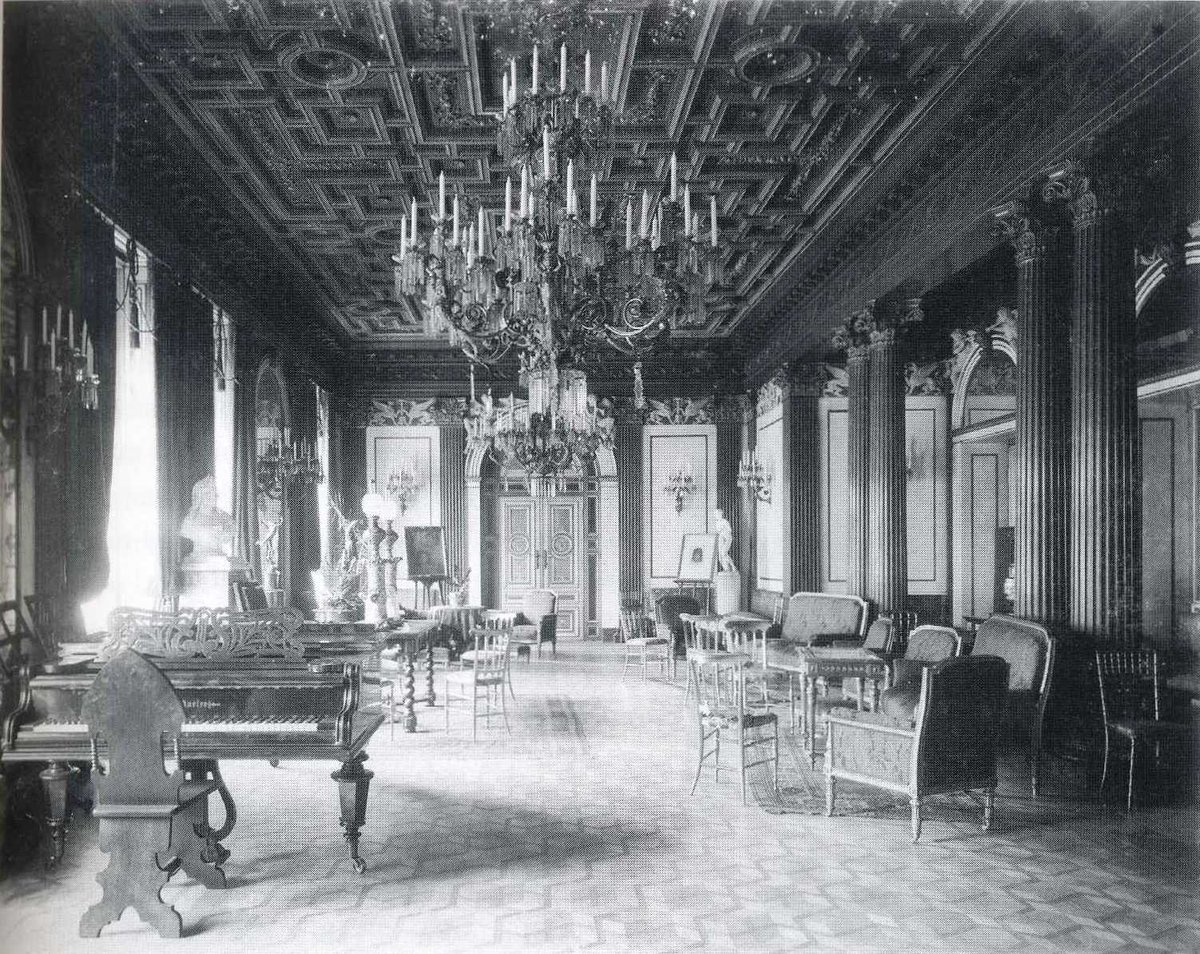
Palais Todesco Vienna: Visiting Hours, Tickets, and Historical Guide
Date: 14/06/2025
Introduction
Palais Todesco, situated at Kärntner Straße 51 in Vienna’s Innere Stadt, is a distinguished landmark from the city’s 19th-century Ringstraße era. Erected between 1861 and 1864 for Eduard von Todesco—a prominent Jewish banker and industrialist—and designed by the acclaimed architect Theophil Hansen, the palace stands as a testament to Vienna’s transformation into a cosmopolitan metropolis. Renowned for its Neo-Renaissance architecture and its role as a social, cultural, and intellectual hub, Palais Todesco is a must-see for visitors wishing to immerse themselves in Vienna’s imperial and artistic legacy. While the palace is largely private today, its striking exterior, adaptive reuse as the home of Café-Restaurant Gerstner, and proximity to iconic sites like the Vienna State Opera make it a highlight of any visit to Vienna’s historic center.
Find official visitor information and updates on the Vienna tourism site, Planet Vienna, and Austria-Forum.
Historical Overview and Significance
Palais Todesco exemplifies the social and cultural innovation that defined Vienna’s Ringstraße period. Commissioned by the Todesco family, influential Jewish financiers, the palace’s construction coincided with a wave of urban modernization following Emperor Franz Joseph I’s decree to replace the old city fortifications with a grand boulevard. Designed in the Neo-Renaissance style by Theophil Hansen, and with contributions from Ludwig Förster, the palace is a showcase of artistic ambition and technological progress (Planet Vienna; Austria-Forum).
Baroness Sophie von Todesco’s salons, hosted in these lavish interiors, became legendary for their inclusivity and their influence on Viennese Modernism, drawing notable figures like Johannes Brahms and Franz Grillparzer (Wien Geschichte Wiki). The palace thus not only stands as an architectural marvel but also as a beacon of Vienna’s intellectual and artistic life.
Architectural Features
Exterior
Palais Todesco’s five-story Neo-Renaissance façade, accented by arched windows, pilasters, and decorative reliefs, is a defining feature of Vienna’s Ringstraße (Planet Vienna; Austria-Forum). The building’s grand proportions and use of red marble columns exude a sense of opulence and symmetry. Its foundations, supported by pilings due to the former city moat, reflect the engineering challenges and innovations of its era.
Interior
The palace’s interior is a Gesamtkunstwerk—a total work of art—where architecture, painting, and decorative arts are harmoniously integrated. The main floor (Beletage) features grand salons and the Festsaal (ballroom), distinguished by a gilded coffered ceiling and red marble columns. Decorative highlights include:
- Ceiling frescoes by Carl Rahl and Gustav Gaul, notably in the Salon Paris, which features mythological themes.
- Lavish wood paneling and gilded ornamentation, creating an atmosphere of luxury.
- Early central heating and preserved ceramic stoves, showcasing technological advancement (Planet Vienna).
Social and Cultural Role
The palace was a nucleus for Vienna’s elite and intellectuals. The Todesco salons were famous for fostering creativity, inclusion, and lively debate, welcoming guests from diverse backgrounds. This tradition of “living pictures” (tableaux vivants), musical performances, and literary discussion helped shape Vienna’s reputation as a center of European culture (contexttravel.com).
After World War II, Palais Todesco served as the headquarters of the Austrian People’s Party, reflecting its adaptability and continued civic relevance (Wikipedia).
Preservation and Adaptive Reuse
Following damage during World War II and subsequent restoration, the palace has been carefully preserved and adapted for contemporary use. Officially recognized as a protected monument since 1976, Palais Todesco now houses the renowned Café-Restaurant Gerstner, allowing visitors to experience its historical ambiance alongside Viennese culinary traditions (Gerstner Palais Todesco).
Visiting Palais Todesco
Location and Accessibility
- Address: Kärntner Straße 51, 1010 Vienna, opposite the Vienna State Opera.
- Public Transport: U-Bahn stations Karlsplatz (U1, U2, U4) and Stephansplatz (U1, U3) are within a 5-minute walk. Trams and buses also serve the area (Gerstner Palais Todesco).
- Accessibility: The palace is wheelchair accessible, with elevators and ramps. Some event spaces may have limited access; advance inquiry is recommended.
Visiting Hours and Tickets
- Café-Restaurant Gerstner: Open daily from 8:00 to 22:00. No entrance fee for café patrons.
- Palace Interiors: Access to event spaces and salons is by reservation or during special events. The palace does not offer regular public tours; guided tours must be arranged in advance (Gerstner Palais Todesco).
- Exterior Viewing: The façade can be admired at any time; no ticket required.
Booking and Contact
- Reservations/Events: For private tours or event bookings, contact +43 1 526 13 61 or [email protected] (Gerstner Palais Todesco).
Visitor Experience and Practical Tips
- Dress Code: Smart casual attire is suggested, especially for evening events.
- Photography: Permitted in public areas; may be restricted during private functions.
- Best Times to Visit: Weekday mornings or early afternoons are quieter. Reservations are recommended for weekends or holidays.
- Nearby Attractions: Combine a visit with the Vienna State Opera, Albertina Museum, Musikverein, and St. Stephen’s Cathedral—all within walking distance.
Café-Restaurant Gerstner
Enjoy classic Viennese pastries, tarts, and cakes at the historic Café-Restaurant Gerstner, a former imperial and royal court confectioner. The café’s elegant setting, with views of the Vienna State Opera, offers a refined atmosphere perfect for savoring Vienna’s coffee house tradition (Travel Tyrol).
Special Events and Private Functions
Palais Todesco is a popular venue for weddings, corporate events, and cultural evenings. The palace’s adaptable event spaces combine historic charm with modern amenities, making it ideal for celebrations and conferences (Gerstner Palais Todesco).
Cultural Insights and Local Etiquette
Embrace Vienna’s tradition of Gemütlichkeit—relaxed enjoyment—by lingering over coffee and cake as locals do. Staff uphold a high standard of service, and guests are encouraged to be courteous and respectful of the palace’s historic setting (Travel Tyrol).
Frequently Asked Questions (FAQs)
Is Palais Todesco open to the public?
Yes, visitors can access the café and public areas during business hours. Access to historic interiors beyond the café is limited to private events or by reservation.
Are guided tours available?
Not regularly; private tours must be arranged in advance.
Do I need tickets to visit?
No tickets are needed for the café. Special events or private functions may require reservations.
Is Palais Todesco wheelchair accessible?
Yes, with elevators and ramps for ease of access.
What are the best times to visit?
Weekday mornings or early afternoons are less crowded.
Are there nearby attractions?
Yes, the palace is surrounded by Vienna’s top cultural sites, including the State Opera and Albertina Museum.
Summary and Insider Tips
Palais Todesco is a symbol of Vienna’s architectural elegance, cultural vitality, and historical evolution. Its Neo-Renaissance design, intellectual heritage, and role as a gathering place for both locals and tourists make it a unique destination. While interior access is generally limited, the grand café and special events provide a taste of aristocratic Vienna. For the most rewarding experience, plan your visit during quieter times, make reservations for the café if possible, and explore the surrounding Ringstraße landmarks.
For the latest updates on opening hours, events, and tours, consult the Gerstner official website and the Vienna tourism portal. Download the Audiala app for tailored guides and timely visitor tips.
